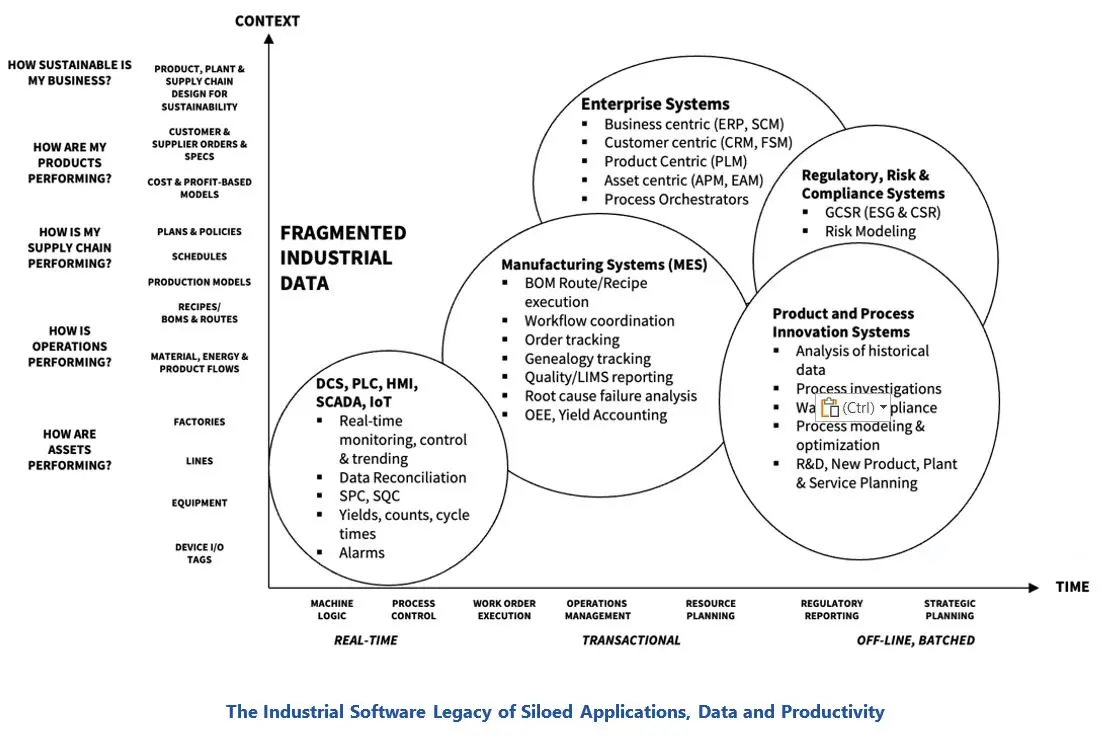

Prior to 2020, any observer would have considered the industrial software landscape conservative and slow-moving. However, since 2020, industrial leaders have built further on significant investments made to digitize data and digitalize processes during the pandemic, combining them with recent breakthroughs in generative artificial intelligence (AI), to accelerate scale out of a wide range of industrial AI use cases, further widening their productivity and profitability advantage, and creating a measurable “digital divide.”
Whether it is political unrest, climate disruption, pandemics, or global macroeconomic uncertainty, industrial organizations are perpetually concerned about their operational resilience and agility. They routinely face pain points and cost drivers, including rising energy costs, supply chain disruptions, material shortages, rising prices, workforce skills gaps, sustainability requirements and more. Advancements in AI could not have come at a better time to help mitigate these challenges and improve business resiliency to ensure short and long term viability increase competitive advantages in the marketplace.
Recent Generative AI breakthroughs are an evolutionary step in the domain of Industrial AI, but their impact on the user interaction paradigm for industrial software solutions is revolutionary. AI is now seemingly infused into all industrial software from the shop floor to the C-suite, requiring new architectures, and new levels of data, security, and governance.
The third in our Industrial AI (R)Evolution series of ARC Strategy Report provides specific recommendations for closing the digital divide by embracing Industrial AI, and governing and guiding major decisions about enterprise, cloud, industrial edge and AI software, using ARC’s Industrial Software Assessment Methodology.
This report is the third in a series by ARC Advisory Group on the Industrial AI (R)Evolution. This report digs deeper into navigating AI confusion and making decisions on rationalizing and simplifying Industrial “Software for the AI (R)Evolution." Read our first report on The industrial AI (R)Evolution for ARC’s definition of Industrial AI, and ARC’s Industrial AI Impact Assessment Model for people, processes, and technology. For help on identifying how you are doing next to your industrial peers in your adoption of AI, see where you stack up across 25 Industrial AI use cases in the second Report on How Leaders Are Embracing Industrial AI.
For decades, ARC Advisory Group has been dissecting the industrial software landscape, advising clients on the myriad of software and hardware needed to design, source, manufacture, deliver, and maintain sustainable products from the factory floor to the customer's door. Despite waves of innovation and consolidation, the typical industrial organization has a complex tapestry of siloed applications, held together by the digital version of duct tape - MES. And by MES, we don't mean manufacturing execution systems that are part of that tapestry, but the ubiquitous Microsoft Excel Spreadsheet.

Most industrial organizations have consolidated their enterprise software such as ERP, CRM, PLM, and SCM. For many, however, their factory and production software landscapes remain a fragmented mess. This fragmentation results in data, process, and productivity silos that are now barriers to the opportunities presented by the AI revolution.
The flood of announcements coming out of the AI War threatens to create “analysis paralysis” as IT, OT, and ET decision-makers, already siloed and disconnected, struggle to make sense of what's real and what to prioritize for their business leaders. This report aims to provide clarity and direction in this complex landscape, helping organizations navigate the AI (R)Evolution effectively and efficiently. Stay tuned as we delve deeper into these issues and provide actionable insights for your organization.
While the AI War headlines are dominated by the hyperscalers’ battles for AI talent, the battle for the next large language or mixed mode model, or Nvidia’s domination of the AI battle for datacenters, there’s lots of other battles, skirmishes, alliances, and lobbyist campaigns shaping the industrial software landscape.
Incumbent industrial software and hardware vendors are actively engaged in the AI War across many of the aforementioned battlefronts. Many ARC clients are asking whether ERP and MES are solid foundations for the new era of AI, and if they can take industrial organizations from edge to hybrid edge and cloud, at the necessary pace? Can Industrial Clouds with a stranglehold on AI talent, and Foundation Models, accelerate migration to the cloud, and value realization from Industrial AI use cases?
Enterprise Resource Planning (ERP) systems, often criticized as legacy software, may finally be on the verge of delivering on their long-promised benefits of process integration, thanks to the advent of AI. The complex user interfaces and proprietary data structures that have traditionally been stumbling blocks for ERP systems are becoming less of an issue as AI provides new ways to navigate and extract insights from these systems. With the advent of generative AI tools, ERP vendors now have powerful new capabilities at their disposal, leaving them with few excuses for not delivering on their promises.
Executive Overview
Industrial Software: A Legacy of Siloed Applications, Data, and Skills
Capitalizing on the (A)bsolutely (I)ncredible Industrial AI Opportunity
ARC’s Industrial Software Modernization Methodology for the AI (R)Evolution
Recommendations
ARC Advisory Group clients can view the complete report at the ARC Client Portal.
Please Contact Us if you would like to speak with the author.
Obtain more ARC In-depth Research at Market Analysis

